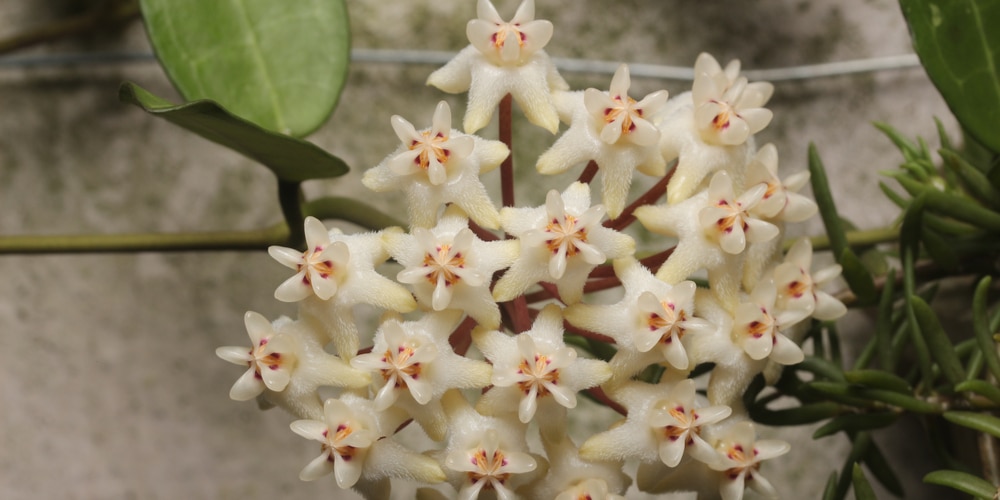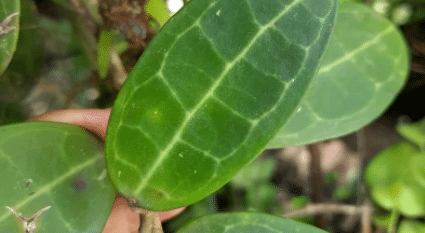Hoya Elliptica is one of the most beautiful of all hoya varieties. This amazing vining plant has a unique color pattern that has been compared to a turtle shell.
If properly cared for Hoya Elliptica will produce a breathtaking bloom. The flowers are star-shaped and white with eyepopping red centers.
These fast-growing hoyas have become very popular among those looking to get into the hobby. Let’s learn a little more about this versatile variety.
Hoya Elliptica Native Region

While this plant variety can be found in many different parts of the world, it is only native to Australia. Being native to only a small part of the world makes Hoya Elliptica one of the rarer hoya species.
Propagation
If you are starting a Hoya Elliptica from a cutting, there are two ways of propagating it. Water propagation and soil propagation are popular ways to turn cuttings into new plants.
Water Propagation
Probably the most common type of hoya propagation is water propagation. To start this process, you will need to find a container that will support the stem. The length of the container you choose will be determined by the length of the stem.
Pour enough water into the container to cover the lowest node on the stem. The rest of the stem should be left above the water. This will help reduce the risk of rot.
You will need to change the water occasionally to help promote root growth. After about 6 weeks of being in the water, the plant will develop a strong root system. Once the roots system has been established, it will be time to transplant the stem into a pot.
Soil Propagation
The next type of hoya propagation is soil propagation. The process of soil propagation is basically the same as water propagation. Instead of submerging the stem in water, you will be placing it directly into the soil. Make sure that your cutting contains no more than 3 nodes.
It is important to choose potting soil that is light and airy. This will give the roots room to develop and allow moisture to reach them. You will need to keep the soil moist at all times in order for the roots to grow.
After your hoya has developed a strong root system, may want to choose to repot it in different soil. Doing so will provide proper drainage and the nutrients needed to develop into a full plant.
Hoya Elliptica Growth and Care
If you are looking to purchase one of these eye-catching plants, there are some things you need to know. While Hoya Elliptica is not the most difficult hoya to grow, it does have specific needs. Below is a compressive care guide that will help you take care of the new addition to your hoya collection.
Soil Requirements
Hoya Elliptica requires well-drained soil that contains a high level of organic matter. If using store-bought potting soil, add in a handful of perlite. Coco coir or vermiculite can also be added to the soil, to help with drainage.
Fertilizer Requirements
Having well-drained soil that contains plenty of organic matter will help it grow to its fullest potential. Fertilizer is not required as long as you repot your hoya once it doubles in size. If your hoya is growing slower than normal, you should repot your plant once a year. This will give it a boost of nutrients needed to thrive.
Water Requirements
Some people make the mistake of overwatering their hoya. This can be very dangerous for the plant, and you could even lose it. This variety of hoya does extremely well in drier soil and should only be watered sparingly.
It is recommended that you allow the soil to almost completely dry out between waterings. However, you should keep an eye on your plant and look for signs of wilted leaves. Wilted leaves are a sign that your plant isn’t getting the moisture it needs. On the other hand, if you notice the yellowing of the leaves, it is a sign that you have overwatered your hoya.
Light Requirements
Hoya Elliptica loves plenty of indirect sunlight. To give your plant the sunlight it needs to grow, place it 3 feet from a sunny window. If you don’t have a sunny window, you may want to consider using grow lights to provide the plant with enough light exposure. Avoid direct light because this may damage the leaves of the plant.
Humidity Requirements
Unlike some hoyas that thrive in high humidity, Hoya Elliptica doesn’t require lots of moisture in the air. This hoya variety gets its moisture from the roots. Watering your plant sparingly will give it all the moisture it needs to grow.
In the winter, you should keep an eye on your plant to make sure it is getting enough moisture. During the winter the air is dryer and may pull moisture out of your plant. You may have to water your hoya more frequently during this time. Keep in mind that overwatering can cause root damage and leaf loss.
Pattern of Dormancy
Many hoya varieties of hoyas go into a state of dormancy during certain parts of the year. Hoya Elliptica doesn’t have a pattern of dormancy, making it a faster grower.
This is one reason why it has become one of the most popular varieties among new hoya owners. If your Hoya Elliptica has slowed growth, make sure that it is getting the right amount of sunlight and moisture.
Location Matters
Before bringing a Hoya Elliptica home, you will need to choose a good location for the plant. As you have learned above the plant will do well if placed 3 feet from a sunny window.
Depending on your local climate, you may need to adjust the location of your plant. Avoid placing your plant in cold or drafty locations, especially during the winter months.
Conclusion
Now that you know more about Hoya Elliptica, you can feel confident taking care of your very own. Remember that this plant loves indirect sunlight and doesn’t require frequent watering.
It is an easy plant to care for and doesn’t require a lot of attention. If this plant has impressed you, why not consider adding one to your collection? There are also many varieties of Hoya available including the hoya krohniana or hoya pubicalyx.
Related Article: Hoya Krohniana Silver
